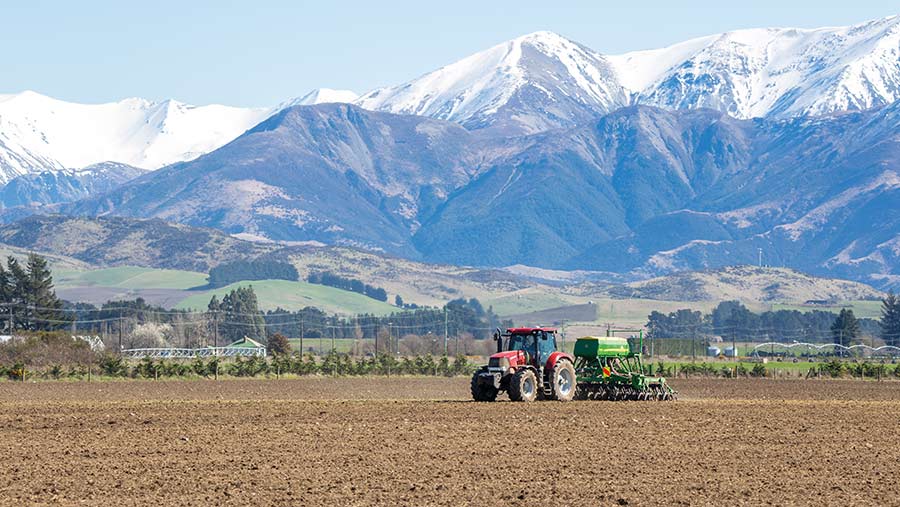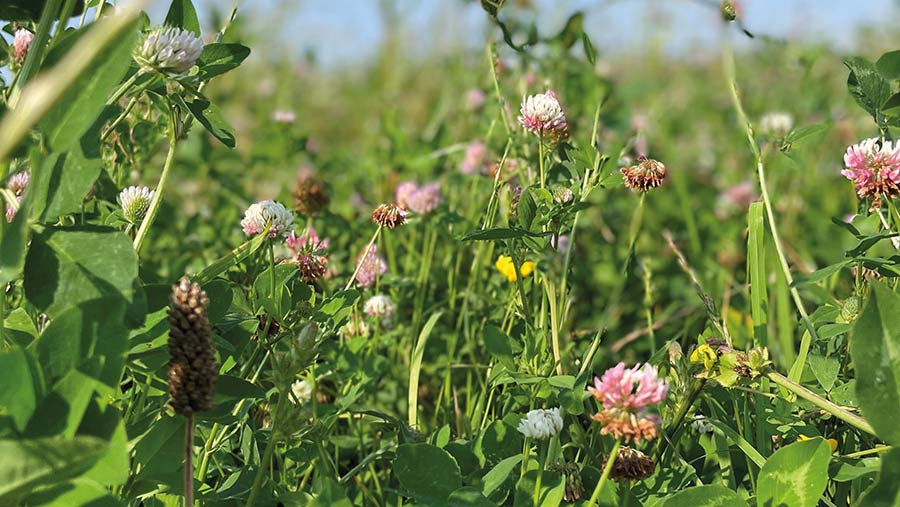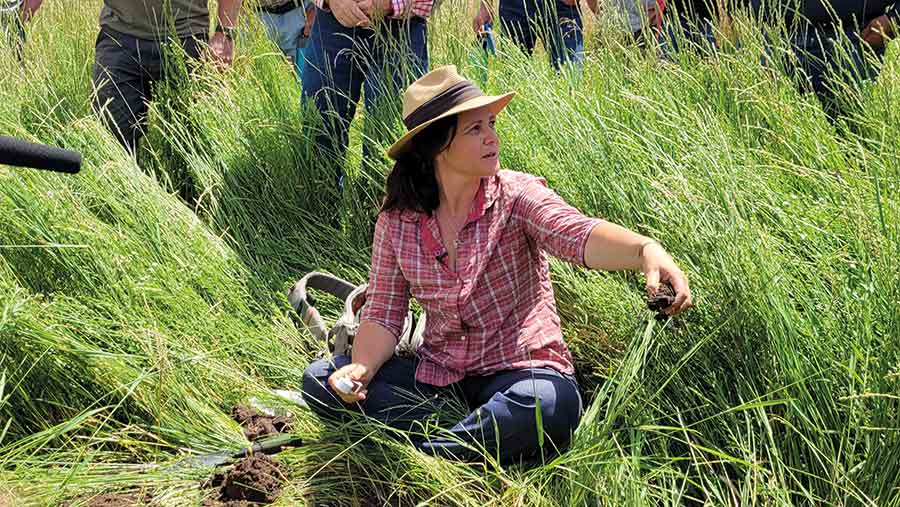New Zealanders share soil fungi knowledge to improve crops
 © Sheryl/Adobe Stock
© Sheryl/Adobe Stock Adopting regenerative farming practices can help increase levels of soil fungi, thereby improving soil structure and making nutrients and water more available to crops.
Practices such as ploughing, applying di-ammonium phosphate and an over-reliance on nitrate fertilisers and pesticides can lead to an over proliferation of bacteria, at the expense of other microbes.
These heavily bacterial soils resulting from intensive arable cropping are much less productive and are prone to compaction.
See also: How home-made compost improves soil health for two farms
New Zealand agroecologist Nicole Masters points to work carried out at New Mexico State University showing that fungi-bacteria ratios are more closely related to crop performance than soil levels of nitrogen, potash and phosphate.
“As the fungal-to-bacteria ratio increases, yields increase,” she says.
It’s not just yield, an imbalance also enables disease-causing microbes to proliferate, along with root-damaging nematodes.
“What leads to disease is lack of disease-suppressing organisms,” she says.
Bacterial soils
A key characteristic of soil with lots of bacteria is that nutrients are locked up. Bacteria consume and retain urea nitrogen, root exudates, pesticides and simple sugars.
Bacterial soils also have poor structure, as they form micro-aggregates – they easily slake and become compacted in the top layer.
“You are likely to get a surface crust with just moss and lichens growing on the soil surface and pan formation. Therefore, water won’t move through the soil – you can have a saturated surface and still be dry underneath.”
Bacterial soils are higher in nitrates and this leads to the characteristic nitrate-loving weeds such as fat hen, nettles, thistles, nightshade and foxtail barley. “If you see these, you have a nitrate problem.”
Fungal benefits
Moving to fungi, they have a role in suppressing disease and decomposing organic matter, and while they retain nutrients, unlike bacteria, they will release them to plants.
Fungi, with their long hyphae, also form macro aggregates that hold soils together. Ms Masters says when soils slump on a hillside, it is due to a lack of fungi, not plant roots.
“Soils will slake if there is not enough fungi,” she says.
Many soils contain a lot of phosphate, but it is unavailable. However, fungi are able to harvest this phosphate and make it bioavailable to plants. “So if farmers have a P deficiency, they will have a fungal deficiency.”
Fungi also create water – they bring water up from depth and hydrate soils, she says. “Fungal soils tend to be more moist than bacterial ones.”
So with all these benefits, what level should farmers aim for in a healthy soil? She suggests aiming for a 4:1 ratio of fungi to bacteria in soil.
One way to lift the ratio is to feed them. Fungi require more complex carbons, “brown materials”, than bacteria, such as brown mature grass, cellulose, lignin, chitin, stubble straw, humates, biochar and woodchip.
Feed the soil
- Bacteria and fungi require different foods
- Typically, bacteria thrive on more simple carbon sources – “green materials”, molasses, sugar, fruit juice, milk, fish emulsion
- Fungi require more complex carbons – cellulose, lignins, “brown materials” such as humates, woodchip, fish oils
Another way is to do less of the practices that reduce numbers, such as soil disturbance and heavy use of fertilisers.
“Once you apply soluble phosphate, you lose mycorrhizal fungi. That’s because plants no longer need phosphate from the fungi.”
Ploughing also reduces mycorrhizal fungi, as it breaks up hyphae.
Fungi are valuable in carbon capture. “Plants pay their microbial workforce with carbohydrates and fungi can lay down inorganic carbon. “
So you need active fungi to sequester carbon. They produce carbonite [rock], and for this sequestration to be permanent, it needs to be at least 40cm down and that is what fungi do.”
What about other microbes?
Protozoa and nematodes also have a role in healthy soils and need feeding along with fungi and bacteria.
Protozoa consume bacteria and are vital for nutrient and nitrogen cycling. “They are a food source for higher organisms.”
Nematodes are often seen as a pest, but 95% are beneficial. They eat bacteria, fungi and each other, releasing nutrients to plants.
The non-segmented worms also help to keep the balance of fungi to bacteria. “If soils are bacterial, it means they don’t have any nematodes,” Ms Masters explains.
Compost and vermicast (organic matter produced from a worm farm) are rich in nematodes and protozoa and will inoculate soils. Protozoa are also found in compost.
Protozoa tea
Another way to inoculate soils with protozoa is by using a protozoa tea. This involves taking top-quality lucerne hay and soaking it in water for three days.
Protozoa will go through a breeding cycle in that time. Then dilute to spray at 20 litres/ha. “If it starts to froth, then it needs more water.”
And avoid tap water, as that will kill them off, she says.
Case study: Tim Williams, Cornwall
Organic farmer and consultant Tim Williams has embarked on a five-year project to nurse soils back to good health at 64ha Erth Barton Farm on the banks of the River Tamar.
A key part of his approach is to make soils more fungal, and he is already seeing beneficial changes less than two years on.
Originally from New Zealand, Mr Williams moved to the UK after five years managing one of the country’s leading regenerative farms.
He brought with him more than 20 years of experience and a deep understanding of regenerative and low-input farming practices.
In October 2020, he took on Erth Barton farm, which was ready for regeneration following decades of high-input arable farming.
He recalls that soils were in bad shape and structure was breaking down. “They were devoid of life.”
The problem was that soils were heavily bacterial dominant and they needed to become more fungal.
So his vision is to transition the farm from an annual cropping system to one that is more perennial, and he sees livestock as the key tool.
Leys and livestock

© the Land Gardeners
His first move was to establish a complex 30-species herbal ley/cover crop and rotate livestock around the farm.
It was designed for feeding livestock, as the system has to pay for itself.
“Liveweight gain is the key payer, as I am a contract farmer and it is what I am being measured by.”
The mix included annual grasses, brassicas, herbs and legumes. Each of these encourages different biology.
All the seeds were mixed and drilled together to create maximum diversity and he uses cattle to manage the plants.
“I want to maximise photosynthesis as this will introduce carbon to the soil the quickest. Animals also introduce biology the fastest, so I graze the cover crops.”
He explains that grasses need to be longer and lignified to feed soil fungi. “We let plants grow up and the livestock then trample them when mob-grazing.”
He will also top grasses when less mature to get sugars into soil to feed the other microbes.
Compost
To enhance the complexity of the soil biology, he is using compost and is working with the Land Gardeners, trialling their microbially rich Climate Compost.
He bio-primes seed with the compost and then direct-drills it.
Mr Williams is also turning it into compost tea and has built his own small compost tea sprayer to apply it. Fields are treated during times of stress.
Since starting out, soils that started by being very bacterial (9:1) are now much more fungal and approaching a 1:1 ratio of bacteria to fungi. He hopes to push it even higher in the coming years.
Future cash crops?
The key question he is now trying to answer is, how to get a cash crop in the system? He is looking to direct-drill wheat into a herbal ley and has had mixed success so far.
His aim is to have a one-year fertility-building ley, rotating cattle around the farm. Then in the second year there will be a cash crop of wheat.
To enable this, he built a sub-soil strip-till system, as the ground was so compacted from the years of intensive farming.
He then used a spring tine cultivator to work the top 5cm before drilling with a Moore Unidrill disc drill.
Last year, he found that the festulolium and ryegrass were too competitive and didn’t work. He has switched them for annual ryegrass in his second attempt.
He says the wheat is now coming up, with 20 different viable species still beneath.
He plans to graze the wheat this autumn with lambs and, hopefully, this will yield a good harvest next summer.
Biopriming a farm devoid of biology
- Add biology to seed
- Apply compost tea when crops stressed
- Establish very diverse, species-rich herbal leys
- Cattle are key to feeding soil fungi
Nicole Masters

Nicole Masters © ???
Nicole Masters has an in-depth knowledge of soil science and ecology.
A New Zealander, she now lives in the US and her consultancy work sees her advise on 26m acres worldwide. Many of her clients are in Australia.
She also runs courses through her agroecological education company, Integrity Soils, to coach consultants and farmers in regenerative practices and is the author of the book For the love of soil: strategies to regenerate our food production systems.
She is planning to run a workshop in the UK in 2023.
Nicole Masters and Tim Williams were speaking at a recent two-day soil workshop at Althorp Estate, Northamptonshire

